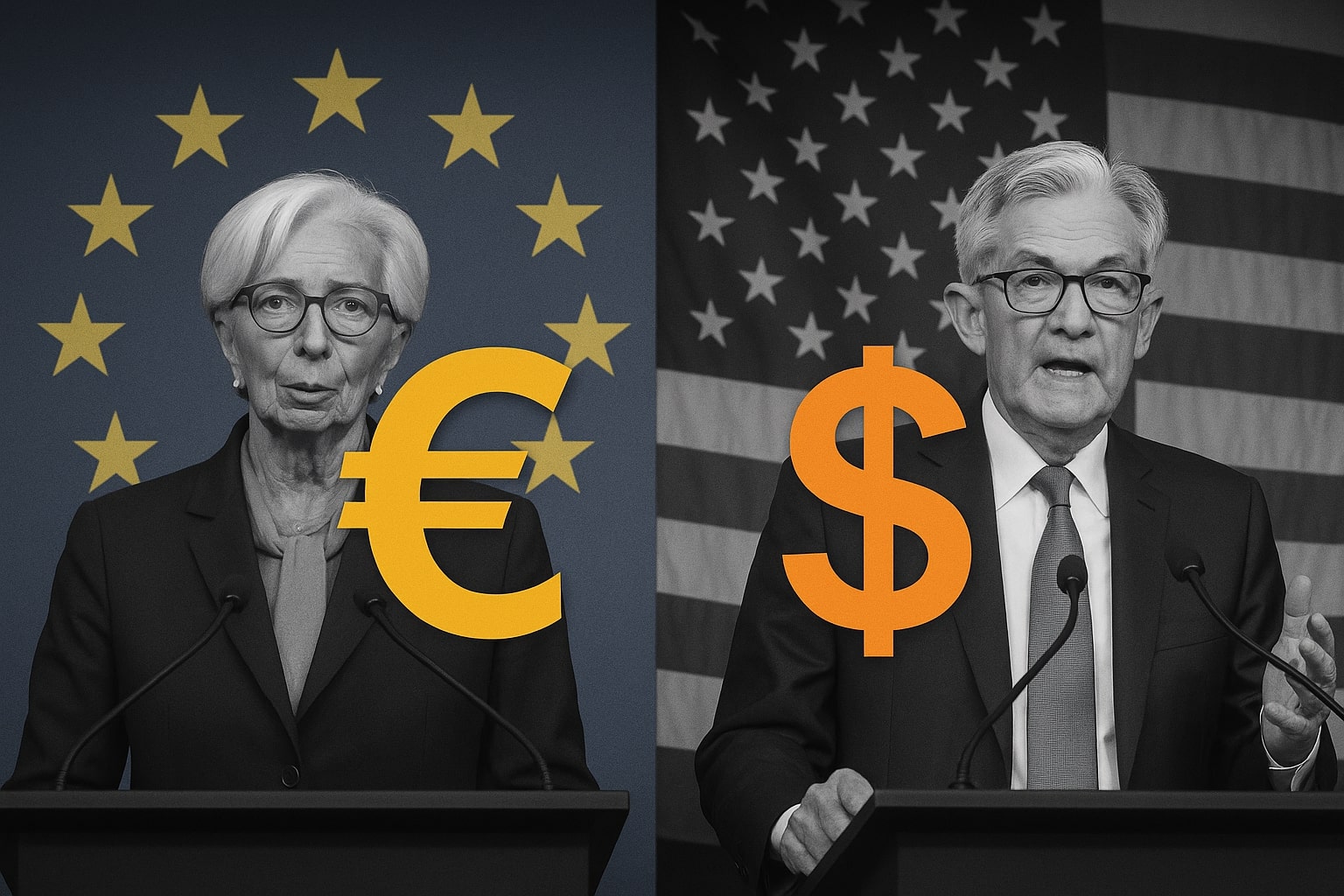
EUR/USD Price Forecast - Euro Slides to 1.1518 as, Dollar Strength Drive Selloff Toward 1.1450
The euro extended its decline for the fifth session, trading near 1.1518 as the U.S. dollar regained dominance.Fed cut expectations falling to 65% | That's TradingNEWS
EUR/USD Price Forecast - Euro–U.S. Dollar Extends Slide Toward 1.1450 as Fed Hawks and Dollar Strength Crush Momentum
The EUR/USD pair continues its relentless decline, tumbling to 1.1518 in Tuesday’s European session after five consecutive days of losses. The euro’s weakness reflects a clear market verdict: the U.S. dollar’s monetary and yield advantage remains firmly intact. The pair’s retreat from 1.1600 highs early last week to current levels near 1.1520 underscores a powerful trend driven by reduced Fed cut expectations, U.S. political instability, and a muted European recovery.
The shift was triggered when Federal Reserve Chair Jerome Powell dismissed aggressive easing bets, stating that policy remains “data dependent.” Following his remarks, the CME FedWatch Tool showed December rate-cut odds collapsing to 65% from 94%, propelling the Dollar Index (DXY) back to 99.97, its highest in a month. The 10-year Treasury yield rose to 4.09%, reinforcing the greenback’s carry appeal. In contrast, the European Central Bank (ECB) maintained its rates unchanged for the third consecutive meeting, offering no catalyst for buyers.
EUR/USD Technical Breakdown: Support Zones Emerge Near 1.1450–1.14
Technically, EUR/USD remains entrenched in a downward channel that has dominated price action since September. The pair trades below all major moving averages: the 20-day EMA at 1.1608, the 50-day EMA at 1.1582, and the 100-day EMA at 1.1639, confirming that momentum remains decisively bearish.
Immediate resistance sits at 1.1570–1.1600, a convergence of the short-term EMA cluster and channel midpoint. A sustained close above this level would be required to neutralize the current bearish sequence. However, as long as the pair remains below 1.1550, downside pressure persists, targeting the 1.1450–1.1400 support range.
The Parabolic SAR dots remain firmly positioned above the price line, reinforcing downward control. Momentum oscillators show limited recovery—RSI near 34, MACD in deep negative territory—both confirming that sellers dominate. Should EUR/USD breach 1.1450, the next critical level emerges at 1.1386, corresponding to the 200-day EMA (1.1399) and May’s prior demand region. A slide below this level could expose 1.1350–1.1300, marking a potential five-month low and a full retracement of the summer advance.
Fed–ECB Policy Divergence Intensifies Dollar Advantage
The primary driver behind the pair’s collapse lies in the U.S.–Eurozone policy divergence. Fed officials have retained flexibility while the ECB appears cornered by slowing growth and stagnant wage momentum. Recent data show Eurozone GDP growth of just 0.2% QoQ and headline inflation falling to 2.6% YoY, both diminishing the case for further tightening.
Across the Atlantic, U.S. macro resilience remains intact. The ISM Manufacturing PMI rebounded to 51.4, its first expansion in nearly a year, while U.S. job openings (JOLTS) stood at 9.47 million, defying slowdown expectations. These figures not only justify the Fed’s cautious stance but also elevate the dollar’s yield differential advantage—now at 1.82% over German 10-year Bunds, the widest since August.
Meanwhile, ECB policymakers including Francois Villeroy de Galhau and Martins Kazaks adopted a balanced tone, acknowledging that inflationary risk has moderated but stopping short of signaling any easing. Their neutrality failed to offset Powell’s firmness, leaving EUR/USD vulnerable to further downside.
Macro Drivers: Political Risk and Safe-Haven Rotation Fuel USD Demand
The ongoing U.S. government shutdown impasse paradoxically boosted dollar demand as investors sought liquidity amid political uncertainty. While the stalemate in Washington threatens fiscal operations, global investors remain anchored in Treasuries as the least-risk asset. The Dollar Index (DXY) benefited from this “liquidity premium,” rising nearly 0.7% week-to-date.
Simultaneously, risk aversion in equities—with the S&P 500 down 0.75% to 6,800.83 and Nasdaq off 1.3% to 16,278.22—has driven further USD inflows. The EUR/USD pair’s inverse correlation with U.S. yields and equity risk has reasserted itself, amplifying the bearish momentum.
Eurozone Data Fails to Support EUR Recovery
The euro found no reprieve from domestic data. The Eurozone Manufacturing PMI held at 45.6, its 18th straight month below 50, while Germany’s factory orders fell 2.1% MoM, underscoring persistent industrial weakness. Although the ZEW Economic Sentiment Index inched higher to –3.2 from –8.9, the improvement remains too marginal to alter capital flows.
Even more concerning, core CPI slowed to 2.8% YoY, down from 3.0%, confirming that inflation pressures are fading faster than expected. The result is a policy trap for the ECB—unable to tighten but unwilling to ease—leaving the euro’s trajectory at the mercy of the dollar.
EUR/USD Market Sentiment and Positioning
Commitment of Traders (CFTC) data reveal that speculative accounts have deepened their short exposure on the euro. Net shorts increased by 18,400 contracts to –62,700, marking the highest bearish positioning since May. This aligns with the Euro Index’s 0.9% weekly decline, highlighting persistent capital rotation out of Europe.
Retail positioning via IG Client Sentiment shows 68% of traders long EUR/USD, a contrarian bearish signal suggesting potential for another leg lower. Meanwhile, the option volatility skew shifted in favor of puts, with 1-month EUR/USD risk reversals at –1.45, reflecting the heaviest downside bias in three months.
Read More
-
IVE ETF Near $212: Is This S&P 500 Value Play Still Cheap for 2026?
20.12.2025 · TradingNEWS ArchiveStocks
-
XRP ETFs XRPI at $11.07 and XRPR at $15.76 Power $1.2B Inflows as XRP Fights for $2
20.12.2025 · TradingNEWS ArchiveCrypto
-
Natural Gas Price Forecast: NG=F Tests $3.60 Support as LNG Boom and $5 Henry Hub Calls Build Into 2026
20.12.2025 · TradingNEWS ArchiveCommodities
-
USD/JPY Price Forecast - Pairs Surges After BoJ’s 0.75% Hike as Pair Eyes 161.50 Resistance
20.12.2025 · TradingNEWS ArchiveForex
Technical Pattern and Price Zones: Channel Breakdown Confirmed
The descending structure visible on the 4-hour chart highlights a well-defined bearish channel bounded by resistance at 1.1600 and support near 1.1450. The median line at 1.1520 has repeatedly capped rebound attempts. A clean close below 1.1500 confirms the breakout, projecting a measured move to 1.1380 based on channel width extension.
Volume data corroborate this move: spot FX turnover rose 14% week-over-week, driven by heavy selling interest from institutional desks in London and New York. The Euro’s 10-day average true range (ATR) expanded to 0.0082, indicating heightened volatility consistent with momentum-based selling.
Correlation and Relative Performance: Euro Trails All Majors
Year-to-date, the euro ranks as one of the worst-performing G10 currencies, down 2.7% versus USD and 4.3% versus CHF. Against the yen, EUR/JPY trades at 177.45, holding steady due to Japan’s ultra-dovish policy stance. However, in the broader cross-market picture, the euro’s weakness is most visible versus high-yield peers: EUR/AUD fell 1.1% this week, EUR/NZD dropped 0.8%, and EUR/CAD declined 0.5%, confirming broad underperformance.
Forward Outlook: U.S. Data to Dictate Near-Term Trajectory
Traders are bracing for upcoming ADP employment data and U.S. CPI readings, both critical for Fed trajectory. A robust jobs report could solidify the Fed’s pause and send EUR/USD tumbling below 1.1450, while softer data might trigger a relief rally toward 1.1600.
Until then, technical momentum, positioning, and macro divergence all favor the dollar. Only a decisive break above 1.1650 would challenge the current bearish setup.
Verdict: EUR/USD Rated SELL – Short-Term Bearish, Long-Term Neutral
Based on technical and fundamental convergence, EUR/USD remains under heavy selling pressure with no immediate signs of reversal. The break below 1.1500 opens the path to 1.1450–1.1400, while sustained closes beneath 1.1450 expose 1.1380–1.1300 in the coming weeks.
As long as the Fed maintains a data-dependent stance and yields hover above 4.0%, the dollar’s dominance remains unchallenged. The euro’s recovery prospects hinge entirely on a U.S. data miss or a policy pivot from the Fed—neither of which appears imminent.
EUR/USD rating: SELL — short-term downside toward 1.1400, neutral longer-term pending confirmation of a structural bottom near 1.1350.



















